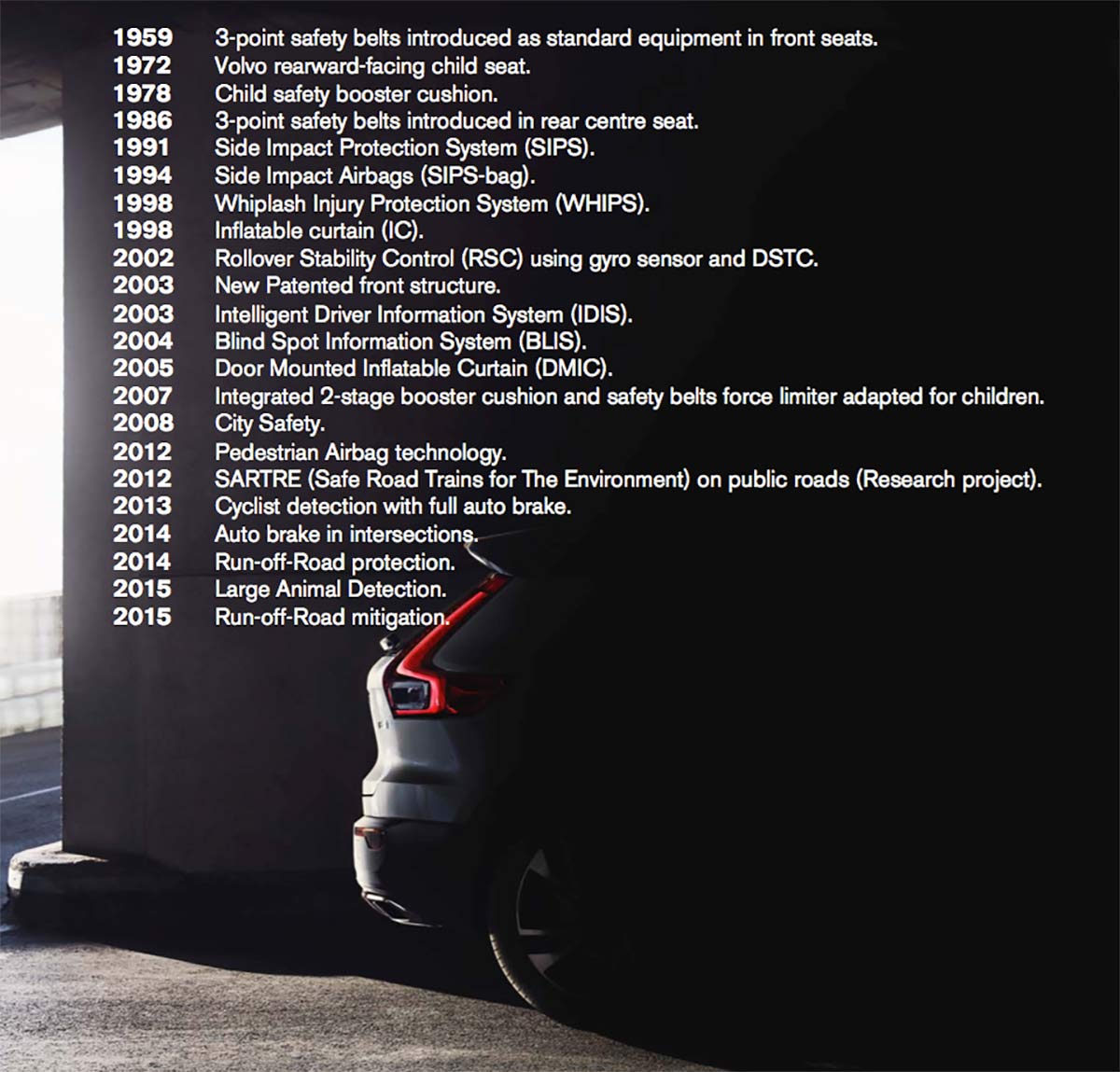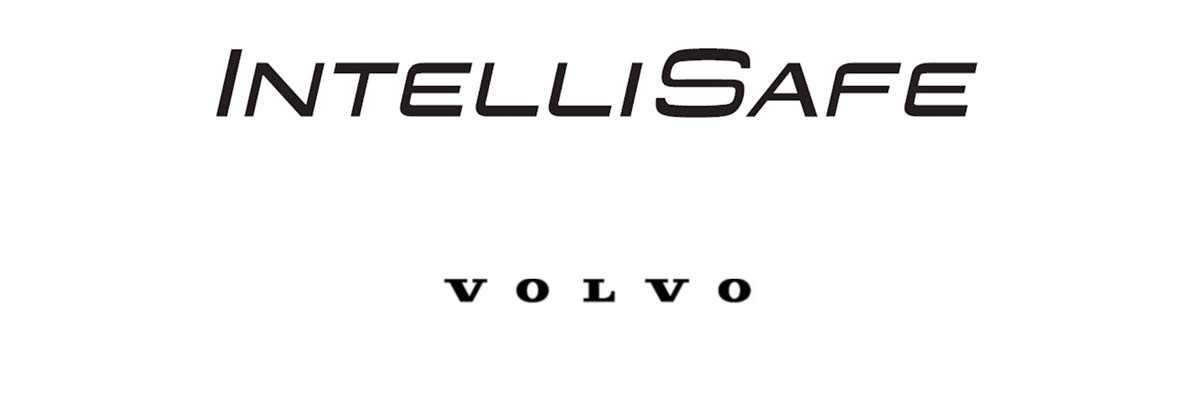
Our vision:
No one will be seriously injured or killed in a new Volvo by 2020.
A factsheet on safety technology in the new Volvo XC40
XC-40
Introducing the New 2022 Volvo XC40 – the small SUV that’s big on innovation. With expressive design, ingenious storage and smart technology, it’s built for city life.
Volvo Cars is synonymous with safety, and the advanced features in the XC40 are the result of decades of experience and innovation - they are there to help you avoid a collision and protect you and your passengers if one should occur.
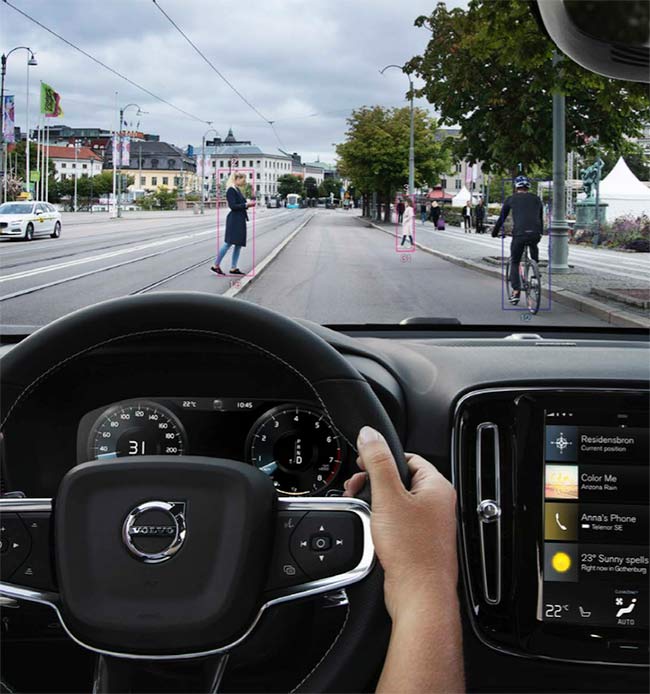
Volvo Cars’ Approach to Safety
Our industry-leading approach is a unique method of tackling vehicle safety
Volvo Cars has always put people and safety first: from the design and implementation of the first three- point safety belt in 1959, to the first booster cushion for children in 1978, and the Side Impact Protection System (SIPS) in 1991, our focus has always been on people and real world safety. As our founders, Assar Gabrielsson and Gustaf Larson expressed back in 1927: “Cars are driven by people. The guiding principle behind everything we make at Volvo, therefore is – and must remain – safety”.
A key component of Volvo Cars’ unique approach to safety is the Traffic Accident Research Team which was established in 1970.
Since its inception, the team has gathered and studied extensive amounts of real-world crash data. This data provides detailed information regarding crash influencing factors, vehicle technologies and occupant injuries. In total, 43,000 accidents with more than 72,000 occupants were analysed since 1970.
Based on the data from the Traffic Accident Research Team, Volvo Car’s safety engineers establish safety targets and testing protocols, develop safety technologies and investigate the safety performance of cars in real-world traffic. This procedure is what Volvo Cars calls its ‘Circle of Life’.
Using this data, Volvo Car’s safety engineers ensure that every new Volvo car is safer than the previous generation. This systematic, real-life approach is unique in the car industry.
In the last 10 years, this procedure has resulted in a 50 per cent reduction in serious injuries for occupants in Volvo cars.
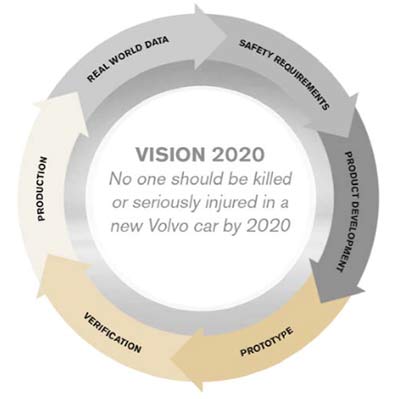
Safety in the new Volvo XC40
Volvo Cars brings a new safety standard to the small SUV premium segment with the launch of the new Volvo XC40. The first car on our new Compact Modular Architecture (CMA) platform will become one of the safest cars in its segment by inheriting safety and support technologies from the larger 90 series and XC60, which are based on the SPA platform. Many of these systems are firsts in the small SUV premium segment. Modern city life presents complex challenges for drivers, pedestrians, cyclists and other road users. The XC40 is designed to reduce driver distraction and the so-called cognitive load on the driver. With safety and driver assistance systems actively identifying and mitigating potential conflicts, the driving becomes more convenient and enjoyable. Features optimized for city driving include a high seating position that gives the driver a clear view of the road, the latest generation City Safety, a 360 ̊ camera and Cross Traffic Alert with brake support to assist the driver in reversing and parking situations. Pilot Assist enables semiautonomous driving during parts of the daily commute. Below are examples of systems in the new XC40. Standard vs. option can vary from market to market.
Standard (examples)
- Latest generation City Safety - works day and night
- Detecting: vehicle, pedestrian, cyclist, large animal
- Warning: light and (sound)
- Preparing: brakes
- Braking: auto brake at all speeds incl. intersection braking
- Run-off Road Mitigation
- Oncoming Lane Mitigation
- Slippery Road Alert & Hazard Light Alert Driver Alert Control
- Road Sign Information
- Lane Keeping Aid
- Safety cage with ultra high strength steel
- Airbags
- Front seats with energy-absorbing functionality
Option (examples)
- Blind Spot Information
- Rear Collision Warning with braking at stand still
- Cross Traffic Alert with brake support
- Volvo on-call safely planning your trip before it starts
- Adaptive Cruise Control – with speed sign assist
- Pilot Assist
- 360° Camera
- Park Assist Pilot
City Safety Technology
City Safety is our umbrella term for our standard collision avoidance functionalities. All City Safety functionalities are standard in the new XC40 and are always active above 4 km/h.
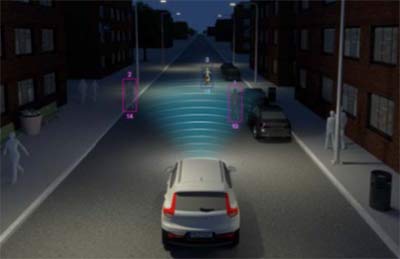
Avoiding or mitigating collisions with other vehicles
City Safety first warns the driver and then brakes automatically if the driver does not brake or steer to avoid vehicles (cars, motorcycles, trucks, buses) that are in front of the car, moving slower in the same direction, braking or not moving. At speed differences up to 60 km/h between the car and the vehicle in front, a collision can be avoided if the driver does not react.
At higher speed differences, the collision is mitigated. The driver can take control and brake and/or steer away at any time to avoid the collision. In speeds above 30 km/h, the front safety belts option are tightened (option in the XC40) to secure the driver’s and front seat passenger’s position option.
Avoiding or mitigating collisions with cyclists
If a cyclist swerves into or is stationary in the path of the car, the City Safety warns the driver and brakes automatically if the driver does not. The car’s speed can be reduced by up to 50 km/h and thereby avoid a collision.
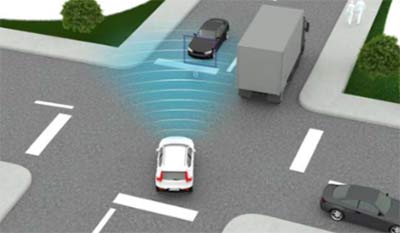
Avoiding or mitigating collisions with oncoming vehicles in intersections
If the driver turns in front of an oncoming vehicle City Safety can assist by braking automatically, if the driver does not brake.
If a collision is imminent, the front safety belts are tightened (option in the XC40) to secure the driver's and front seat passengers' position.
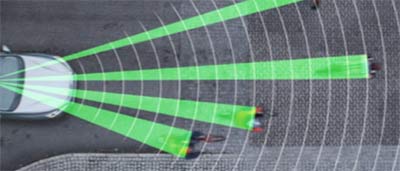
Avoiding or mitigating collisions with pedestrians
If a pedestrian moves into, or crosses the path of the car, or is stationary in the path of the car, City Safety warns the driver and brakes automatically if the driver does not, at speeds up to 80 km/h. A collision with a pedestrian can be avoided at speeds up to 45 km/h. For speeds between 45 and 80 km/h, the collision is mitigated.
City Safety Technology
Large animal detection
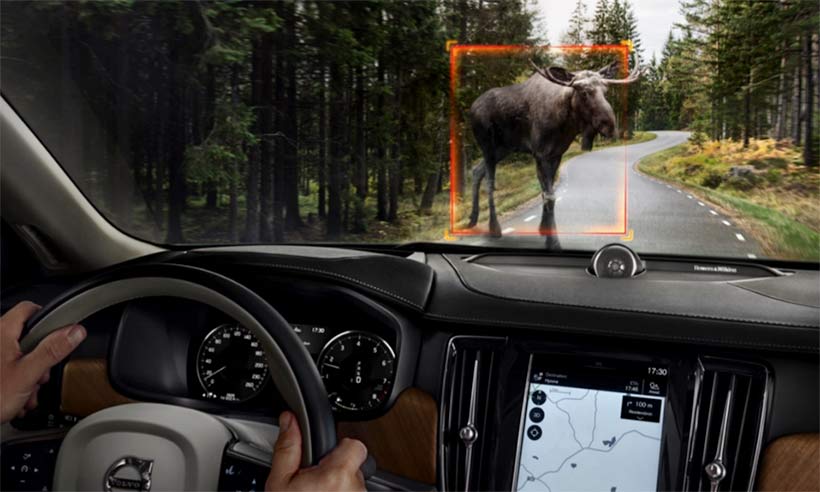
Avoiding or mitigating collisions with large animals
In addition to detecting vehicles, cyclists and pedestrians, City Safety also includes detection of large animals, like moose, elks and horses. The standard-fitted radar/camera unit can detect large animals standing on the road or slowly moving across it with the side towards the car. If a large animal is detected, the system warns the driver. When the driver brakes, additional brake pressure is provided to support avoidance if needed.
If the driver does not react the car applies the brakes to mitigate the possible effects of an impending collision. In this way collisions with large animals can be avoided or mitigated. The car’s speed can be reduced by up to 15 km/h. If a collision is imminent, at speeds above 30 km/h, the front safety belts are tightened (option in the new XC40) to secure the driver’s and front seat occupant’s position..
Oncoming Lane Mitigation
Steering you out of harm’s way
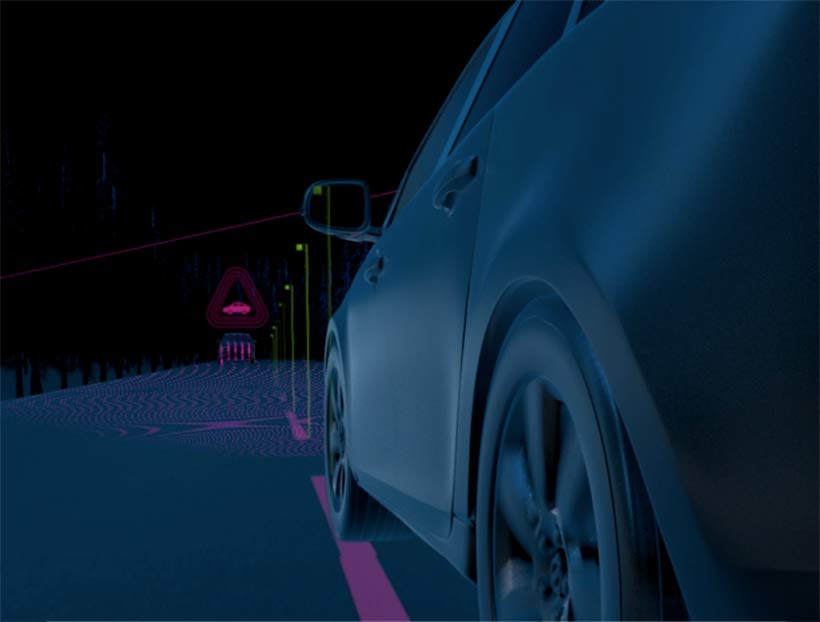
This system helps the driver avoid collisions with oncoming vehicles by assisting them to steer back into their own lane.
If the car drifts over a lane marking, heading into the path of an oncoming vehicle and the driver takes no action, this system automatically steers the car back into its own lane.
A message is shown in the driver display after the steering intervention has been completed. The driver can override the automatic steering at anytime.
The system is active at speeds between 60 and 140 km/h, requires a visible lane marking and detects oncoming four-wheeled vehicles.
Run-off Road
Run-off road accidents are amongst the largest cause of single vehicle accidents. To combat this, Volvo Cars has developed two support systems aimed at helping to avoid a run-off road accident from taking place, or protecting the car’s occupants in the case of an unavoidable road departure.
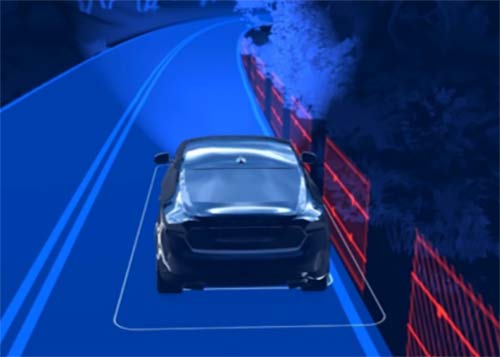
Run-off Road Mitigation
The Run-off Road Mitigation function is designed to help prevent unintentional road departures at vehicle speeds between 65-140 km/h.
Run-off road accidents are amongst the most common type of single-vehicle accidents. Reasons for such accidents include driver inattentiveness, fatigue or poor weather conditions.
When a potential run off road situation arises torque can be applied to the steering to support the driver along with braking action. The system can always be overridden by the active intervention of the driver.
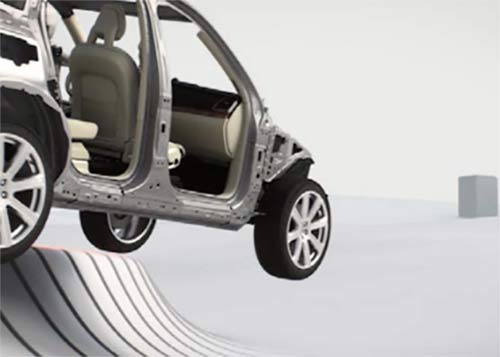
Run-off Road Protection
Run-off Road protection focuses on accidental road departure. Using input from the car’s advanced sensor system, the technology is able to detect a run off road scenario.
When an unavoidable run off road situation arises the front safety belts are electrically tightened (option in the new XC40) as much as possible to keep the occupants in position.
To help reduce spine injuries Volvo has designed the seat structure to deform mechanically to cushion the vertical forces that can arise when the car encounters a hard landing in the terrain.
Based on real-life data, Volvo Cars has developed three complete vehicle crash test track methods, called Ditch, Airborne and Rough terrain, for evaluating the consequences of various Run-off Road protection scenarios.
Lane Keeping Aid
Keeping you on the right side of the line

Lane Keeping Aid is a standard-fitted system that helps the driver to keep the car in its lane by gently steering the car back if it is about to cross a lane marking if the car senses that the driver is not driving actively, or for example, using their indicators.
If the supplied steering intervention is insufficient the driver is alerted by vibrations in the steering wheel.
The system uses the windscreen-mounted camera and relies on visible lane markings. This system can be switched off in the car settings and feedback can be set to vibration of the steering wheel only, vibration and intervention or just intervention.
The system is active between 65-200 km/h.
Connected Safety
Making the most of available technology
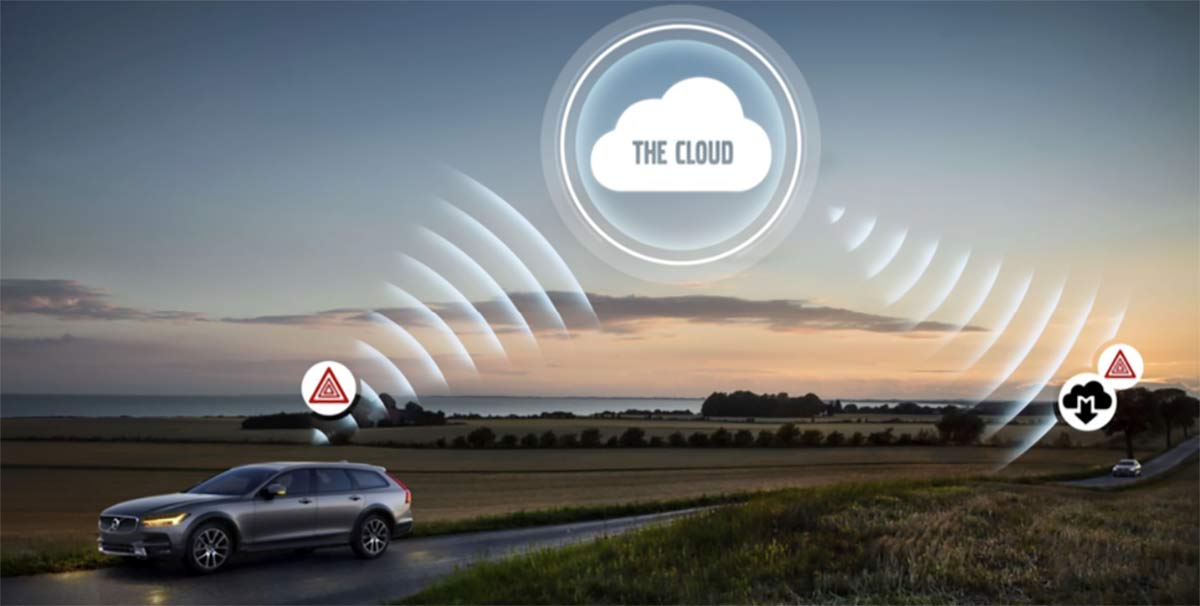
Volvo Cars has always approached product development from a human-centric perspective, utilising the best available technologies to deliver meaningful and useful features and services in the car. With arrival of in-car connectivity, Volvo Cars believes that this can deliver not just added services – but added safety and peace of mind. Connected Safety information is presented to the driver via pop-up icons in the driver display.
For Connected Safety to function the car must have a connection to the Internet. We are developing a number of systems designed to make driving safer and more enjoyable. Here are two examples of existing offerings within the area of Connected Safety.
Slippery Road Alert*
The purpose of Slippery Road Alert is to increase the driver's awareness of both current road conditions and those on the road ahead.
Road friction is measured during steering, braking and/or acceleration. If the friction is below a certain level, the driver receives a slippery road alert in the driver display.
The cloud sends slippery road alerts to connected Volvo cars approaching a low friction zone.
Hazard Light Alert*
The purpose of Hazard Light Alert is to alert the driver about vehicles on the road ahead that have their hazard lights activated.
Awareness of vehicles along the road ahead makes it possible for the driver to prepare and adapt his/her driving style to safely handle the situation.
*Slippery Road Alert and Hazard Light Alert are available in Sweden and Norway.
Road Sign Information & Speed Limiter
A reminder when you need it
At Volvo we understand that you have a lot on your mind sometimes. This is why we have developed Road Sign Information and Speed Limiter features to help remind you of the current speed limit.
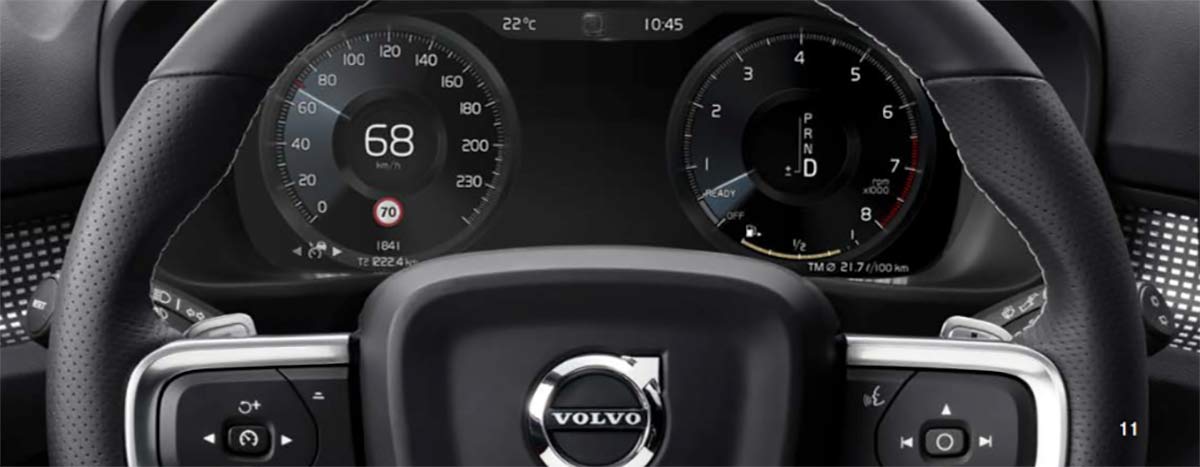
Road Sign Information
Road signs the driver is passing are displayed in the lower part of the speedometer, or on the Head-up display, if fitted. The system can display European and US speed limit signs – including variable speed limit signs – and supplemental sign information, as well as some of the more important European prohibition signs.
The driver can activate/deactivate a speeding alert in the menu system, including a desired offset speed to the detected speed limit. If speeding alert is activated and the driver exceeds the limit, plus the chosen offset, a speed limit sign icon will flash in the speedometer. Information about speed cameras is automatically presented when Road Sign Information is activated. If the speeding alert function is activated and the car exceeds the speed limit when approaching a speed camera, a speeding alert warning is issued as described above. No offset speed is considered when approaching speed cameras.
If the car is equipped with Sensus Navigation, speed limit information is fetched from the navigation unit and combined with the speed signs detected by the camera.
The driver can activate a warning sound for the no-entry sign warnings and speeding alert (disengaged by default).
Speed Limiter
This function limits the speed of the car to that set by the driver, or set automatically with information from the Road Sign Information system.
The driver can exceed the set limit by depressing the accelerator fully for a moment and then choose to drive above the set speed. This is useful for overtaking manoeuvres. When the speed falls below the set speed, the Speed Limiter will resume its function. The set speed is shown in the Driver display.
Driver Alert Control
It’s time for a break...

Distraction, lack of concentration, and falling asleep are major reasons for accidents.
In 2007 Volvo Cars introduced a world-first technology to combat this danger. Driver Alert Control keeps track of the car’s path in relation to lane markings on either side, by means of the camera in the windscreen.
If the system detects that the car is being driven in an erratic manner the driver gets an alert in the form of an audible signal as well as a text message and a coffee cup symbol in the driver display, that indicate it is time to take a break.
With Sensus Navigation, the driver also gets guidance to the next available place to take the break.
Post Impact Braking
Bringing you to a safe standstill
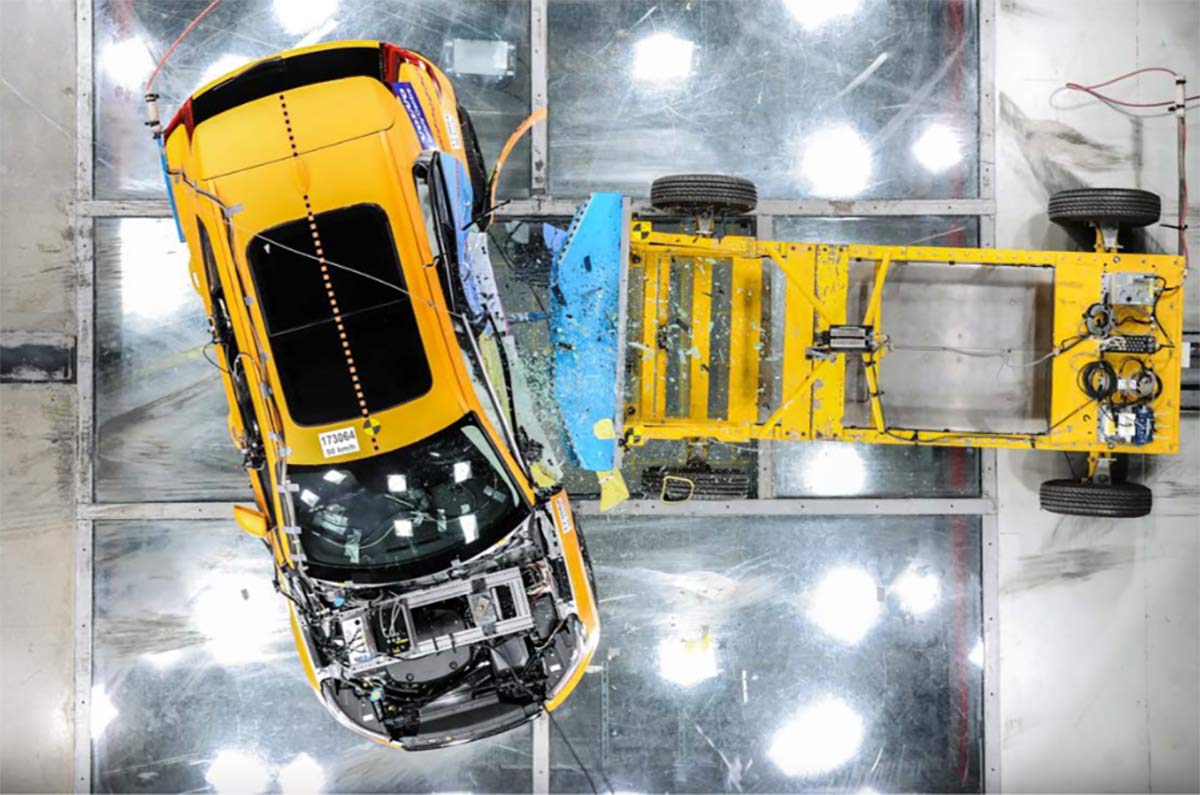
This system is designed to prevent or mitigate a secondary impact when the car has been involved in a collision.
If the airbag is deployed in the primary collision, and providing that the brakes still work efficiently, the electronic stability control system automatically brakes the car down to standstill to counteract another impact, for instance against a vehicle, cyclist, pedestrian or a roadside object.
The hazard warning and brake lights are on during braking – and the hazard lights remain active also when the car has stopped. The parking brake is applied once the car is standing still.
Seats and Safety Belts
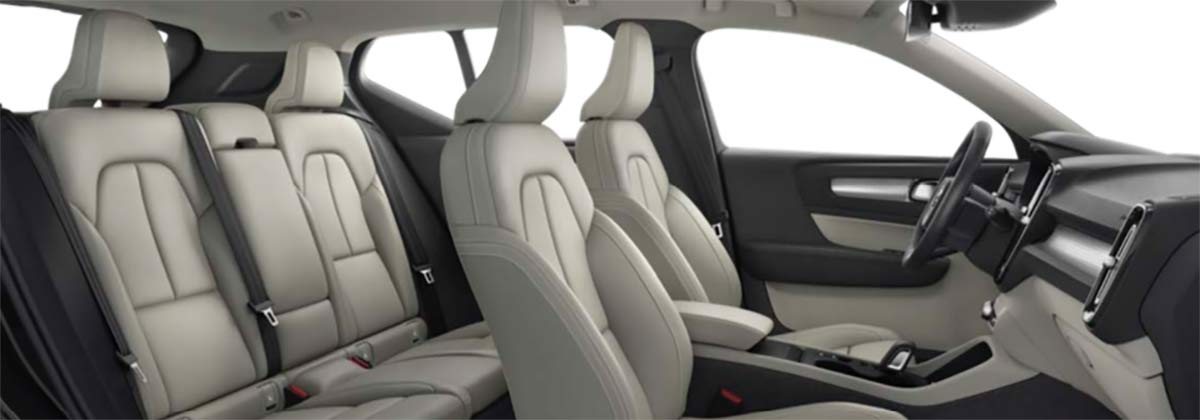
Seats
Our most recent generation of seats have strong frames, made using different grades of steel ensuring safety, flexibility and comfort. All seats have anti-submarining protection integrated into the design ensuring best possible occupant interaction with the safety belt. To help reduce loads to the spine, Volvo has designed an energy-absorbing functionality in the front seats, which cushions the vertical forces that can arise when the car encounters a hard landing in the terrain. Together with SIPS and WHIPS technologies the seats also play a vital role in the event of side impact and rear-end impact.
Whiplash Protection Systems
Relative movements in the cervical spine can cause pain in the neck, often referred to as whiplash injuries. This is the overall most frequent car occupant injury type today, and in some cases it can result in long term pain and suffering. Volvo Cars has been the pioneer in this area, introducing head restraints already in the 1970.
In 1998 Volvo introduced world first Whiplash protection systems, designing integrated functionality in the front seats, called WHIPS. These seats have proven world leading in whiplash protection based on real world data and have served as benchmark for the development of international test methods (e.g. IIHS and EuroNCAP). Since 2015, the second generation of WHIPS is incorporated in new Volvo cars, taking occupant protection to another level.
Volvo’s whiplash injury protection system incorporates the design of the whole seat, including the head restraints. If the car is hit from behind, the seats are designed to provide an even support and to absorb the energy, to minimize the impact to and the relative movements in the cervical spine.
Safety Belts
Safety belts are rarely communicated today as they have been standard on all cars for decades. It can be worth remembering, however, that the three-point safety belt was first put into production by Volvo Cars, having been designed by Volvo engineer Nils Bohlin.
This was in 1959, years before it would be available in most cars. Volvo also pioneered safety belts in the rear seat and a three-point safety belt on the rear seat mid-position. The rear safety belts are not only vital for the passengers using them, but also for the occupants in front.
The three-point safety belt is seen as one of the most important inventions for mankind and it is definitely the most important protective safety feature in the car.
Here are some of the features that now define the latest safety belt technology in Volvo cars:
Comfort is an important part of safety belt design. It ensures the highest possible safety belt usage. This is why Volvo provides height adjusters. The design allows movement and flexibility at the same times as the safety belt is always taught over the body.
Safety belt reminders: Volvo was the first carmaker to install safety belt reminders back in the 1970s.
Safety belt pre-tensioners: In a collision, pyrotechnical pre- tensioners automatically tighten the belts across the body to reduce the occupant’s movement and help provide maximum protection.
Safety belt load-limiters: Load-limiters absorb energy in a controlled way to reduce forces on the human body during a crash
Advanced Restraints
Seatbelts and airbags
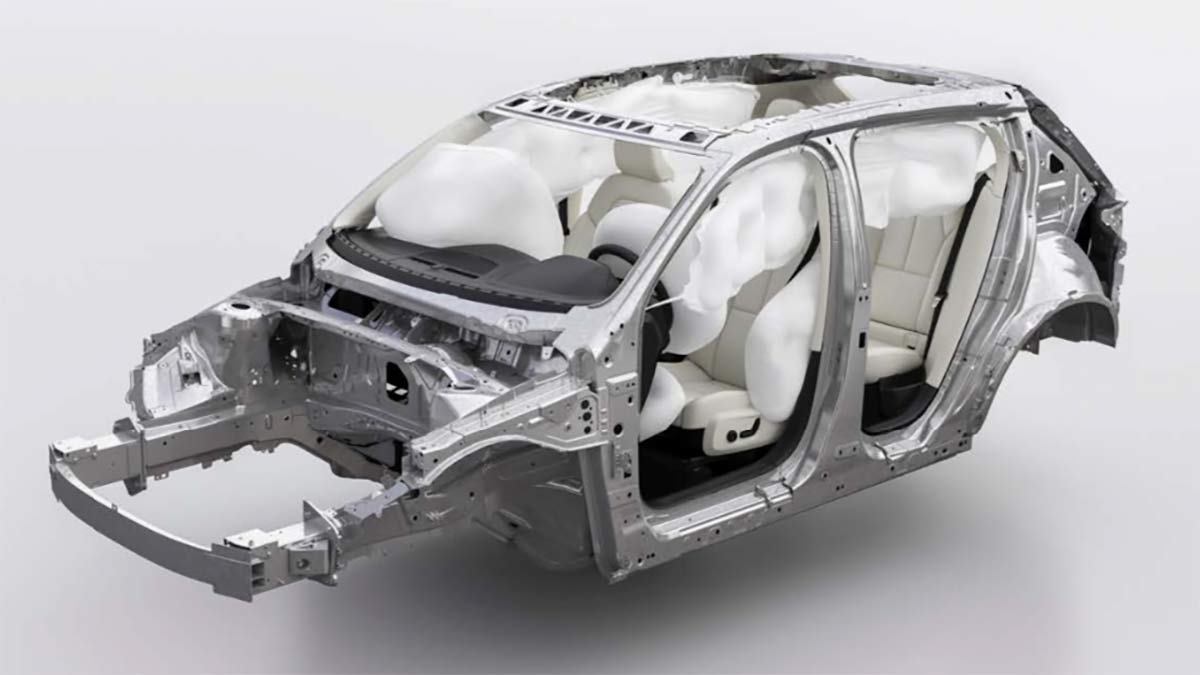
Seats
New Volvo cars contain a range of airbags, designed to help protect the occupants in the event of an accident. The collision is detected by advanced sensors that will deploy the airbags when they are needed. The airbags act as supplement to the safety belt and the other protection systems, and are included when needed.
The driver airbag is positioned in the centre of the steering wheel. The airbag is designed together with the energy absorbing steering column to minimise forces on the driver in the event of a crash.
The frontal passenger airbag is incorporated in the dashboard. Together with the safety belt, the airbag is designed to help protect the front seat passenger. In some markets the airbag can be switched off to accommodate a rearward-facing child.
Side Airbags
Side airbags were pioneered by Volvo in 1994. They were designed to distribute the forces generated in a side impact collision and absorb the resulting energy. The side airbags are integrated into the outer sides of the front seat backrests and help protect the front occupants in the event of a crash where there is a lateral component
Inflatable curtains
Inflatable curtains were a world first introduced by Volvo in 1998. These airbags are integrated in the longitudinal part of the roof above the doors. They inflate from the top down providing added protection for the head for the occupants in both seating rows.
Swedish Steel
Safety cage
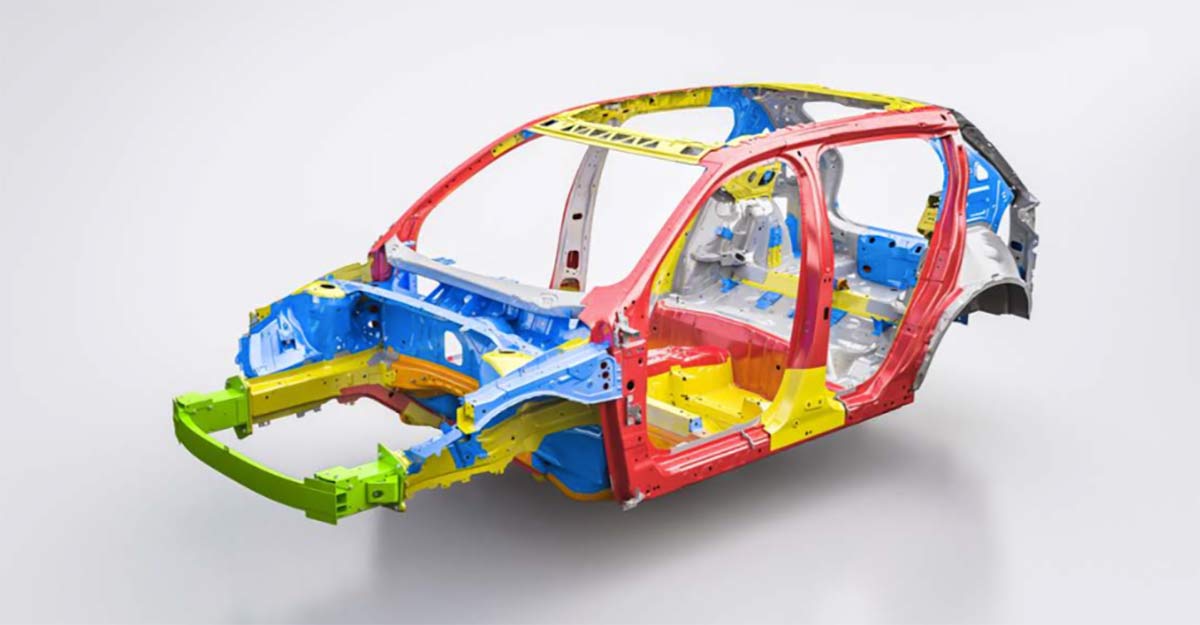
Seats
To help keep the occupant space inside intact in a crash, Volvo’s new XC40 has been made stronger in every sense. This is achieved by the usage of hot-formed boron steel, which is the strongest type of steel presently used in the car body industry and the construction itself.
The complete safety cage around the occupants is made from hot- formed boron steel and is designed for maximum occupant protection in all types of crash scenarios.
The hot formed steel amounts to 20 per cent of the total body weight in the XC40.
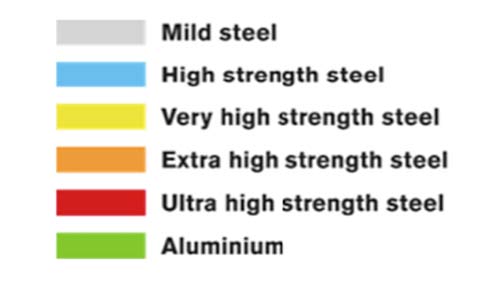
Pilot Assist
Semi-autonomous drive
Pilot Assist assists the driver with steering support, distance and speed control in situations ranging from slow moving traffic jams to free flowing long distance driving on motorways in speeds up to 130 km/h.
Pilot Assist makes driving safer and more convenient in monotonous stop-and-go traffic by adding steering assistance to the highly popular Adaptive Cruise Control functionality.
When the semi-autonomous Pilot Assist system is activated, acceleration, braking and steering are assisted in order to help the driver comfortably follow the traffic flow within the current lane.
This has the effect of reducing driver strain in tedious driving situations and increasing safety margins.
The system also delivers enhanced speed and distance keeping and a more consistent and precise position in the centre of the lane.
Pilot Assist offers steering assistance functionality up to 130 km/h and does not need a lead car. This means that Pilot Assist will be increasingly useful on long motorway trips where the road markings are clearly visible.
However, the driver is expected to actively participate in the driving and remains responsible for monitoring, supervision, and over all operation of the vehicle. It is also important to emphasize that semi-autonomous systems are restricted in how much acceleration, braking and steering force they can apply.
The driver is always responsible for driving the vehicle (driver in the loop: hands on the wheel, eyes on the road, mind on driving).
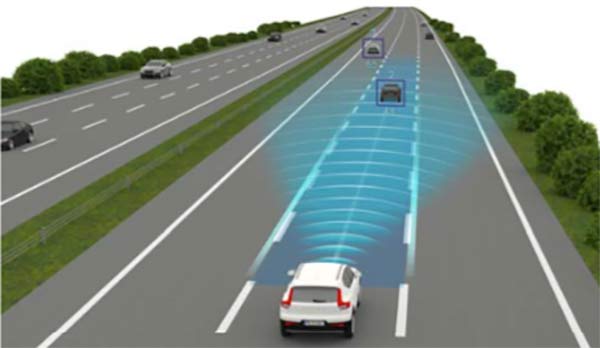
The driver can override the system at any time by using either the brake pedal, accelerator pedal or steering wheel. The turn indicator can be used to temporarily abort the steering support if the driver wants to change lane.
Pilot Assist is automatically switched off if the driver does not keep a hand on the steering wheel.
Interface
Pilot Assist is selected and activated by the driver using the steering wheel buttons on the left side of the steering wheel. Adaptive Cruise Control settings like time gap and set speed are available and the driver display shows necessary status information, i.e. steering support on/off. If the system for some reason must be turned off, the driver receives a warning.
Rear Collision Warning,
Cross Traffic Alert & 360° Camera
Watching your back in the city
Rear Collision Warning with braking at standstill
If a vehicle is approaching from behind and the system calculates that there is a risk of a collision, it flashes all indicators at a higher rate than the regular indicator/hazard warning light rate, to try to catch the attention of the driver of the approaching vehicle. The hazard warning indicator light inside the car is not activated.
If the system calculates that a vehicle is about to hit it from behind, it tensions the safety belts just before the impending collision. If the car is at a standstill, the system also activates full auto-braking. This system is included in the IntelliSafe Surround package.
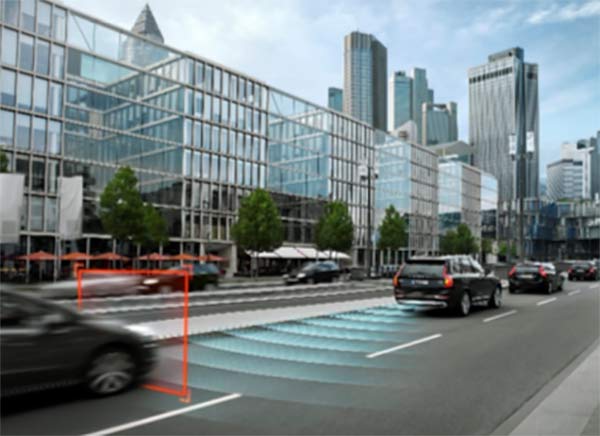
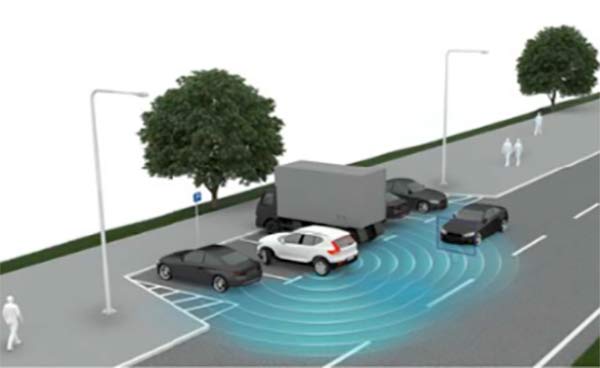
Cross Traffic Alert with brake support
If reversing out of a parking space or anywhere else with a limited field of view on the rear left and right sides, radar units inside each corner of the rear bumper detect vehicles approaching at a distance of up to 30 metres on both sides. The system may also under optimal conditions detect smaller objects, such as cyclists and pedestrians, at shorter distances.
Initially, the driver is alerted by a directional audible warning from the left or right rear loudspeaker and by a graphic symbol on the centre display. If the driver continues to reverse and a collision is imminent, the vehicle automatically brakes to avoid the collision. This system is launched in the new Volvo XC40.
360° Camera
With this option, the driver can see a bird’s-eye view of the car’s surroundings around a virtual picture of the car on the centre display. Objects close to the car are visualised by graphic elements. The 360 surround view is built up with information from four cameras around the car. The cameras can also be selected separately to support the driver in different parking situations.
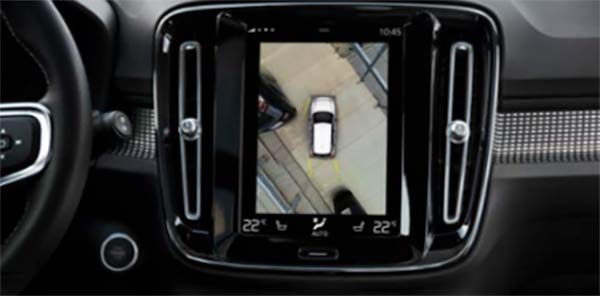
Park Assist Pilot &
Rear Park Assist Camera
Parking has never been easier
Park Assist Pilot
The Park Assist Pilot in the new XC40 facilitates both parallel and perpendicular (bay) parking by taking over and operating the steering wheel while the driver handles the gearbox and controls the car’s speed.
The parking manoeuvre is based on information from ultrasonic sensors around the car. When a parking slot suitable for parallel or bay parking is detected, the car will ask for confirmation by the driver. The Park Assist Pilot then guides the driver step by step via texts and animations in the instrument display until the car is parked.
The function can also assist the driver to manoeuvre out of a parallel parking. The steering is returned to the driver once the car has moved out of the parking slot.
Rear Park Assist Camera
A rear-view camera is available as an option. It is hidden beside the opening touch pad for the tailgate. When the driver engages reverse gear, it shows a wide view behind the car on the Centre display. Lines on the display show the path the rear wheels will take according to the steering wheel angle and dotted lines indicate the exterior dimensions of the car (can be switched off in the menu system). The camera can also be switched to a zoomed-in view to further assist the driver in viewing the towing area.
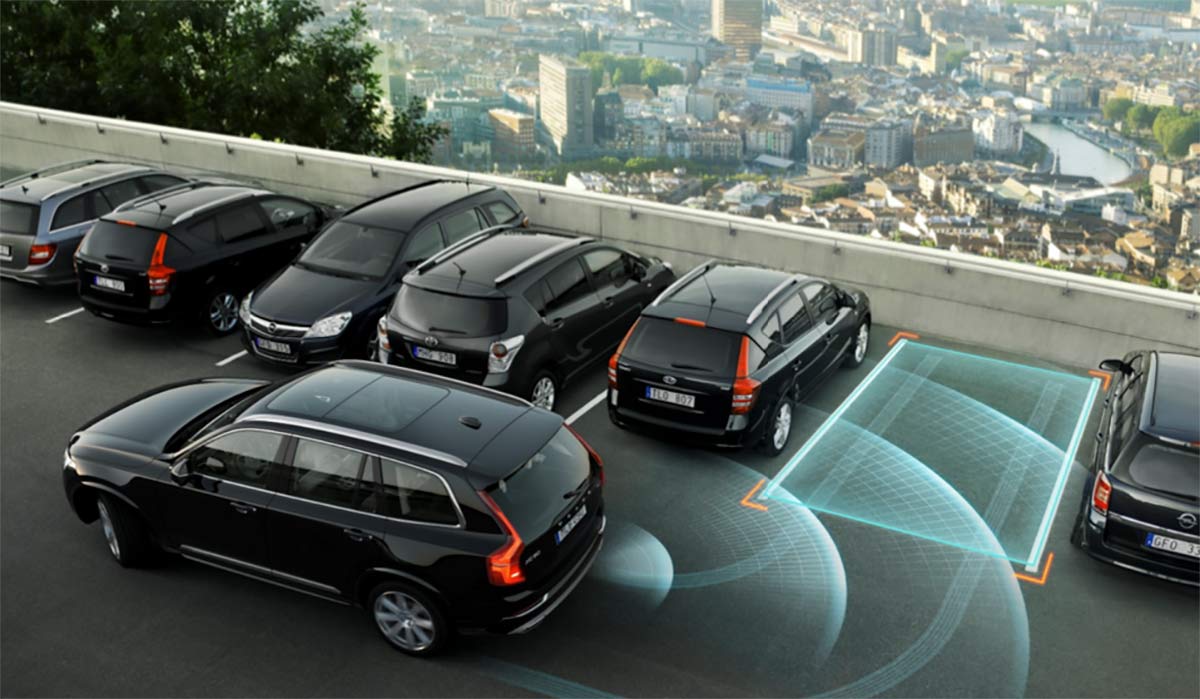
Child Safety
Protecting what’s important to you
At Volvo Cars we look at child safety with both the car and child seat in mind, making them work together in the best way to ensure children have a safe journey. In 1978 we invented the world’s first booster cushion for children. This is one example of our long tradition of work with child safety at Volvo Cars. Today, we have a wide range of standard and optional features as well as accessories, designed with your child in mind. Here are a few of them:
Rearward facing child seats
The safest way of travelling in a car is rearwards. Therefore, babies and young children should travel facing the rear of the car for as long as possible.
All our child seats for infants and toddlers are rearward-facing. They can accommodate a child weighing up to 25 kilograms.
The child seats are easy to install, adjust and remove thanks to their compact design. They are upholstered in durable Wooltextile.
Integrated child seats
A number of Volvo models have integrated child seats available as an option. This is a very user-friendly form of child restraint used together with the three-point safety belt which accomodates a child from 4 years and upwards
Booster seat and booster cushion with backrest
Our booster seat and classic booster cushion are also upholstered in Wooltextile. They are designed for children between 4–10 years (15–36 kg).
ISO-FIX anchorages
Internationally standardized ISO-FIX child seat anchorages are fitted in the new XC40.
Child safety locks
Manual rear door child safety locks are standard. They are operated individually in each rear doors by activating a mechanical locking device in the door end. In locked position, the door cannot be opened from inside.
Power child safety locks
Power-operated child safety locks are available as an option. The locks on both rear doors are operated with a button on the driver’s door. Just like the standard manual child safety locks (which they replace), they lock the interior door handles, preventing the doors from being opened from inside.
Volvo Cars Safety Innovation
A history of world firsts
At Volvo Cars we look at child safety with both the car and child seat in mind, making them work together in the best way to ensure children have a safe journey. In 1978 we invented the world’s first booster cushion for children. This is one example of our long tradition of work with child safety at Volvo Cars. Today, we have a wide range of standard and optional features as well as accessories, designed with your child in mind. Here are a few of them:
